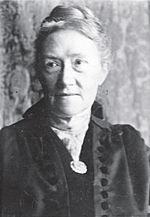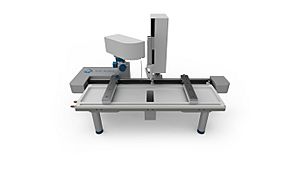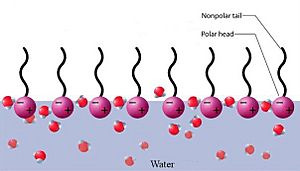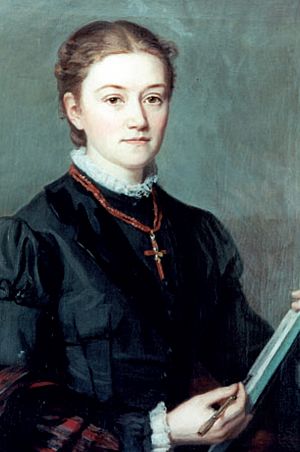Agnes Pockels facts for kids
Agnes Luise Wilhelmine Pockels (born February 14, 1862 – died November 21, 1935) was a German chemist. She made very important discoveries about how liquids and solids behave at their surfaces. This area of study is now called surface science.
Agnes became interested in surface science while doing chores at home, like washing dishes. She noticed how soap affected water. She invented a special tool called a surface film balance. This tool helped her study how tiny particles, like soap molecules, act on the surface of water. Her work helped define the "Pockels Point." This is the smallest space a single molecule can take up in a very thin layer.
Agnes Pockels taught herself science. She was not a paid scientist and did not work at a university. This makes her an example of a citizen scientist.
Contents
Agnes Pockels: Early Life and Learning
Agnes Pockels was born in Venice, Italy, in 1862. At that time, Venice was ruled by Austria. Her father was a soldier in the Austrian Army. In 1871, her family moved to Brunswick, Germany, because her father became sick.
Agnes went to the Municipal High School for Girls there. She loved science, especially physics. However, women in Germany were not allowed to go to universities back then. Agnes once said, "I had a passionate interest in natural science, especially physics, and would have liked to study."
Since she couldn't go to university, Agnes studied science at home. She also took care of her parents. Her younger brother, Friedrich Carl Alwin Pockels, studied physics at the University of Göttingen. He shared his textbooks and other science books with Agnes. This helped her learn a lot from home.
Agnes Pockels' Science Discoveries
How Did Agnes Pockels Start Her Research?
Agnes became curious about how soaps and other things affected water. This happened while she was doing chores, especially washing dishes. By the time she was 18, she started doing experiments at home. She wanted to understand how water and impurities behaved. She was an amateur chemist.
When she was 20, Agnes invented a special tool. It was a metal tray, about 70 centimeters long and 5 centimeters wide. She filled it with water. Then, she placed a metal strip across the water. This strip divided the water surface into two parts. A ruler helped her measure the size of each part as she moved the strip.
Agnes improved her tool by adding a small disk, like a button, to the water surface. She used a weighing scale to measure the force needed to lift the disk from the water. By comparing the force for pure water to water with impurities, she could measure surface tension. This tool helped her study very thin films of molecules. It also helped her understand how impurities change water's properties.
Her sliding trough was an early version of a tool called the Langmuir-Blodgett trough. This modern tool is still used today in science.
What Was the Pockels Point?
Agnes used her sliding trough to see how tiny amounts of impurities affected water. These impurities were often things found at home, like oils and soaps. She measured the surface tension, which was the force needed to lift the disk from the water. Agnes found that even small amounts of impurities greatly changed the water's surface tension.
She specifically studied soapy water. Soaps are a type of surfactant. These molecules have one part that likes water (hydrophilic) and another part that dislikes water (hydrophobic). They don't dissolve well in water and tend to stay on the surface.
Agnes noticed something interesting. When she added small amounts of surfactants, the surface tension didn't change much at first. But once the slider in her trough passed a certain point, the surface tension changed a lot. She made graphs of her results, which showed a sudden change.
Agnes realized that this sudden change happened when the surfactant molecules formed a complete layer, only one molecule thick. This is called a monolayer. She found this point was the same for many different soaps. Because she knew how much surfactant she used and the area it covered, she could calculate the space a single molecule took up. She found it was about 20 square angstroms. This special measurement point later became known as the Pockels Point.
How Did Agnes Pockels Publish Her Work?
Around 1891, Agnes learned that another scientist, John William Strutt, 3rd Baron Rayleigh (Lord Rayleigh), was studying similar things. Her brother, Friedrich, encouraged her to write to Lord Rayleigh. Agnes wrote to him in German, explaining her tool and her findings. She also mentioned that she couldn't publish her work in science magazines.
Lord Rayleigh's wife translated the letter for him. Lord Rayleigh was very kind and not worried that Agnes was an unknown amateur. He sent Agnes's findings to the science magazine Nature. He included a letter explaining her work. This helped Agnes publish her first paper, called "Surface Tension."
Her letter to Lord Rayleigh, dated January 10, 1891, started like this: "My Lord, – Will you kindly excuse my venturing to trouble you with a German letter on a scientific subject? Having heard of the fruitful researches carried on by you last year on the hitherto little understood properties of water surfaces, I thought it might interest you to know of my own observations on the subject. For various reasons I am not in a position to publish them in scientific periodicals, and I therefore adopt this means of communicating to you the most important of them."
Lord Rayleigh's letter to the editor of Nature praised Agnes's work. He said she used "very homely appliances" but got "valuable results." He also said her work raised "many important questions."
Agnes Pockels' Later Work
After her first paper, Agnes continued her studies. She kept writing to Lord Rayleigh. She learned that even tiny bits of dust could affect her experiments. She realized how important it was for her equipment to be very clean.
Agnes found a better way to study monolayer films. She would dissolve a substance in benzene and then put it on the water surface in her trough. This helped her measure the thickness of some films, finding them to be about 13 angstroms thick. With Lord Rayleigh's help, her second paper was published in Nature in 1892.
Agnes also studied other surface effects, like capillarity (how liquids move in narrow spaces). She published 14 science papers, mostly in German magazines. Her last paper came out in 1926.
Agnes Pockels never got a formal job as a scientist. But her work was very important. When Irving Langmuir won the Nobel Prize in Chemistry in 1932 for his work on monolayers, part of his success was based on Agnes Pockels' early experiments.
Agnes Pockels: Personal Life
Agnes spent much of her life taking care of her sick parents. She said this was "very challenging." Her father died in 1906, and her mother died in 1914. After that, Agnes herself became ill and had to stay in a sanatorium for a while. She enjoyed traveling in Europe. In her later years, she was known as "Auntie Agnes" to her family.
Agnes Pockels died in 1935 in Brunswick, Germany. She lived in that town for her entire career.
Agnes Pockels: Awards and Lasting Impact
In 1931, Agnes Pockels received the Laura R. Leonard Prize. She shared it with Henri Devaux. The next year, the Braunschweig University of Technology gave her an honorary doctorate. She was the first woman to receive this award from them.
An American chemist named Irving Langmuir used an improved version of Agnes's trough. He made more discoveries about surface molecules. This work earned him a Nobel Prize in chemistry in 1932. Agnes Pockels' device was a direct ancestor of the Langmuir–Blodgett trough, which was later developed by Langmuir and physicist Katharine Blodgett.
Since 1993, the Technical University Braunschweig has given out the Agnes Pockels Medal. This award honors people who have helped the university, especially those who have supported teaching and research by women.
The Agnes Pockels Laboratory was opened at the Technical University Braunschweig in 2002. It helps teach chemistry and encourages young children, especially girls, to explore science. In this lab, children learn by doing experiments, like a craft, without needing a lot of theory.
Lord Rayleigh kept the letters he received from Agnes and her brother. Agnes also kept a diary. These important documents and family photos are now kept at the library of the Royal Society of Chemistry. In 1932, for Agnes's 70th birthday, a German chemist named Wolfgang Ostwald wrote a biography about her. It included a list of her papers and parts of her own writings.
See also
 In Spanish: Agnes Pockels para niños
In Spanish: Agnes Pockels para niños





